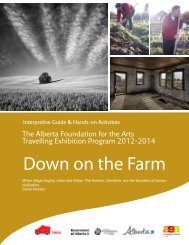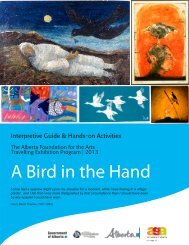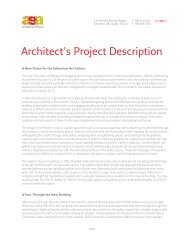Urban Animals - Art Gallery of Alberta
Urban Animals - Art Gallery of Alberta
Urban Animals - Art Gallery of Alberta
You also want an ePaper? Increase the reach of your titles
YUMPU automatically turns print PDFs into web optimized ePapers that Google loves.
The <strong>Alberta</strong> Foundation for the <strong>Art</strong>s Travelling Exhibition Program<br />
<strong>Animals</strong> in <strong>Alberta</strong> <strong>Art</strong>: A Survey<br />
Paul Kane<br />
Assiniboine Hunting Buffalo,1851-1856<br />
Oil on canvas<br />
Collection <strong>of</strong> the National <strong>Gallery</strong> <strong>of</strong> Canada<br />
<strong>Alberta</strong> is a young province, and the<br />
practice <strong>of</strong> Euro-Canadian artistic modes<br />
<strong>of</strong> expression is thus a relatively recent<br />
phenomena in the province. The first<br />
Euro-Canadian artist to practice in the<br />
prairies was Paul Kane (1810-1871) who, in<br />
the 1840s, travelled from Toronto to Fort<br />
Edmonton and on to Fort Victoria. Kane’s<br />
focus was on recording, in a romantic<br />
fashion, the land and human inhabitants<br />
(especially the First Nations peoples he<br />
encountered) <strong>of</strong> the vast western regions for<br />
his eastern patrons. In this pursuit he<br />
naturally recorded the fauna he found in his<br />
travels as well.<br />
A second early Canadian artist also<br />
interested in the fauna <strong>of</strong> the west was<br />
Frederick Verner. Born in Sheridan, Ontario,<br />
Verner (1836-1928) admired the work <strong>of</strong> Paul<br />
Kane, with whom he later became friends.<br />
Because <strong>of</strong> this admiration, Verner decided<br />
to become a painter himself. Emulating Kane<br />
he travelled west to paint Indian scenes and,<br />
by 1873, was the most popular artist<br />
working in Toronto. Like Kane he also<br />
artistically explored the fauna he found in the<br />
west.<br />
In the late 19th century, as expressed<br />
in the work <strong>of</strong> Kane, Verner, and a small<br />
handful <strong>of</strong> other artists, three main<br />
themes were explored in prairie art: First<br />
Nations (and early Euro-Canadian)<br />
peoples and lifestyles; the landscape; and<br />
the animals <strong>of</strong> the west.<br />
Frederick Verner<br />
Buffalo Stampede,1882<br />
Oil on canvas<br />
Collection <strong>of</strong> the <strong>Art</strong> <strong>Gallery</strong> <strong>of</strong> <strong>Alberta</strong><br />
While animal imagery has continued to be an aspect <strong>of</strong> <strong>Alberta</strong>’s artistic heritage since<br />
the 1800s, for most <strong>of</strong> the 20th century this investigation was an undercurrent as animal<br />
imagery came to have little status in the serious art world. As stated by curator Elizabeth<br />
Brown:<br />
There is a feeling, held by many artists and critics, that there is something over-sentimental or<br />
superficial in their (animals) portrayal.<br />
While animal images were produced by various artists in the early decades <strong>of</strong> the twentieth<br />
AFA Travelling Exhibition Program, Edmonton, AB. Ph: 780.428.3830 Fax: 780.421.0479<br />
youraga.ca

















